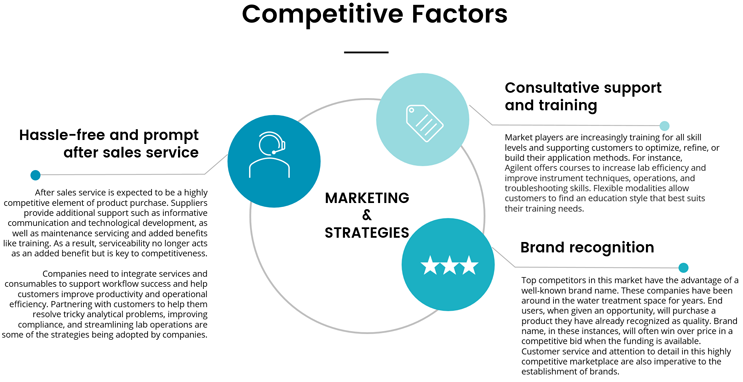U.S. PFAS Analytical Instrumentation Market Expected To Generate Profound Growth Over Next 7 Years
By Shilpa Tiku

The U.S. perfluoroalkyl and polyfluoroalkyl substances (PFAS) analytical instrumentation market is expected to generate profound growth over the next 7 years. Verify Markets estimates that the market will likely grow over 20% compound annual rate over that span. The current slope of the U.S. PFAS analytical instrumentation market advancement is steep due to U.S. EPA plans to propose water and wastewater regulations for PFAS. Additionally, some of the key drivers include an increased awareness about the widespread prevalence of PFAS contamination, public outrage, funding, and litigation scares.
States are increasingly taking action and developing limits. So once PFAS is discovered and determined to be in concentrations that can likely be harmful to human health, each individual state will likely implement more stringent limits. This will have a larger economic effect and higher market revenue.
Product Trends
The top three priorities for a customer seeking PFAS analytical instruments are ease of use, after sales service, and low cost of ownership. Emerging products also provide a variety of advantages to end users which include elimination of extensive and tedious manual handling steps that are known sources of error, high data recovery, improved reproducibility, high sample throughput, and reduced exposure of lab staff to hazardous environments.
End-User Trends
Currently, the demand for PFAS analytical instrumentation from industrial facilities is mainly driven by the need to control the quality of the internal processes and not from the perspective to meet PFAS regulations. For instance, their primary focus is likely to protect a catalyst or maintain the quality of some process.
Most of the utilities send samples for PFAS measurement to commercial testing laboratories because they cannot afford the high capex involved in buying analytical instruments for PFAS. Demand is driven by large wastewater treatment utilities that are predominantly located in areas having industrial waste containing PFAS.
Demand for PFAS analytical instrumentation from regulatory bodies is driven by the need to support ongoing research to help bolster PFAS regulation. Once the regulation is in place, utilities for wastewater and drinking water are likely to drive market growth. Utilities are likely to be either the primary driver of the market, or they will be on par with private/commercial testing laboratories. Over the next 5-6 years, demand from academic research laboratories is likely saturate and the market share of industrial facilities is likely to increase quickly. The focus should increase on industrial pre-treatment and more process control measures will likely be incorporated to minimize or eliminate PFAS discharge.
According to a key industry participant, “PFAS measuring instruments are very expensive and there are a lot of utilities that are not willing to invest that much money in the equipment. So, a lot of the utilities are likely going to outsource that measurement to commercial testing labs. In addition to utilities, there are a bunch of manufacturers that are also worried about being fined from a litigation perspective. It’s unlikely that they will hire highly specialized and trained chemists for PFAS analysis and then go spend half a million dollars on the instrument to do the analysis; these industrial facilities are also going to outsource their measurements. The private labs are likely to get business from both small utilities and industrial customers that are going to be measuring these things. Due to this reason, commercial testing laboratories will continue to make up a substantial component of the market share by end users. Once the PFAS regulations are fully launched, and everybody knows exactly what they are supposed to go after and what the consequences are, the demand for PFAS measuring instruments from municipalities and water treatment facilities will go up, without a doubt.”
Key Players In The Market
The market is still emerging and is very nascent. Some of the key market participants include Agilent Technologies, Inc., Thermo Fisher Scientific Inc., Shimadzu Corporation, and Metrohm AG.
The chart below illustrates the competitive factors in this market.

To read the Verify Markets U.S. PFAS analytical instrumentation market report or request an executive summary, contact Verify Markets at info@verifymarkets.com or call +1.210.595.9687.
About Verify Markets
The Verify Markets team is a group of market experts, creative thinkers, business analysts, and independent consultants located around the world. We work with our clients to bring solutions to every project and deliver reliable data and trends based on primary research. Our Research & Consulting practice provides global industry analysis, custom engagements, end-user analysis, strategy consulting, strategic market intelligence, and forecasts that are designed to facilitate strategic decision-making. Our team continuously monitors and evaluates information to create insights for your business needs.
For purposes of this research, Verify Markets has segmented the market by two measuring techniques: Liquid Chromatography - Mass Spectrometry (LC-MS/MS) and Combustion Ion Chromatography (CIC). At the moment, EPA has only approved PFAS measurement by LC-MS/MS technique. PFAS analysis by CIC technique is at the drafting stage and EPA is currently reviewing the results of the multi-laboratory validation study to finalize the method and add formal performance criteria.
 Shilpa Tiku is the Chief Research Officer at Verify Markets. Mrs. Tiku has experience in research and consulting for over 19 years. She focuses on monitoring and analyzing emerging trends, technologies, and market dynamics in several global markets. To reach her for comments, interviews, or market consulting, call +1 210.595.9687 or email her at shilpa.tiku@verifymarkets.com.
Shilpa Tiku is the Chief Research Officer at Verify Markets. Mrs. Tiku has experience in research and consulting for over 19 years. She focuses on monitoring and analyzing emerging trends, technologies, and market dynamics in several global markets. To reach her for comments, interviews, or market consulting, call +1 210.595.9687 or email her at shilpa.tiku@verifymarkets.com.
